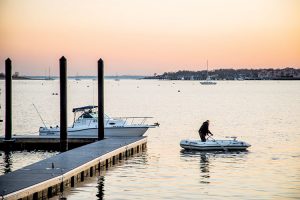ALISON M. JONES grew up in Mountainville in Hunterdon County, with Rockaway Creek passing through.
“It was cold, wrinkled toes and mossy rocks,” Jones said. The creek was part of the 1,100-square-mile Raritan River Basin, but she had no idea of the other end of that watershed about 35 miles away: Raritan Bay. Acquaintances told her the bay stinks.
Then, last year, she rode the Raritan bay by boat.
“It was a beautiful sunset,” said Jones, 66. “We saw dolphins.”
From trout stream to the shared recreational and commercial uses of the 109-square-mile Raritan Bay, and the water ways in between – it is all part of the Raritan Basin, one of six bodies of water being studied by Jones’ non-profit organization, “No Water No Life.”
No Water No Life (NWNL) combines photography and science to raise awareness of the importance of freshwater resources. By focusing on North America and Africa, NWNL believes it can make deeper contrasts and comparisons between watersheds.
“We interview scientists, stewards and stakeholders on our expeditions, (the) voices of the river,” said Jones, a professional photographer who lives in New York City, where NWNL is based.
The other five ongoing case studies are of the Columbia River in the Pacific Northwest and the Mississippi River and the African watersheds of the Nile, Omo and Mara rivers.
Why the Raritan River Basin?
“The Raritan is the disconnect between upstream and downstream,” Jones said. “It’s the largest drainage basin within the nation’s most densely populated state.”
“Why do you think I picked the Raritan as one of our six case-study watersheds?” Jones said. “It’s mine.”
As for Raritan Bay, “it’s a resource that serves 6 million people in New Jersey and New York City,” Jones said. “It’s the largest open space that serves that area.
“We want to do everything we can to protect this resource,” Jones said. “It’s a gem.”
Jones began her scientific pursuit as a nature photographer. Then, she and about 100 others formed the International League of Conservation Photographers in 2005 – with the belief that science could reach more and have a longer impact through photography.
No Water No Life was founded two years later, with Jones as director, a position she still holds.
A history major at George Washington University, Jones worked in advertising and news at Antiques magazine. At about 40, Jones began pursuing photography.
“I saw this course about photography,” Jones said. “It was at a community college. And I was hooked.
“I didn’t think I had a creative bone in my body. What I’ve learned, we’re all creative, (but) we’re blocked.”
Today, Jones, a mother of two adult daughters, is a member of the prestigious Explorers Club. And her exploration, now, includes the Raritan River Basin.

“Now, we are focusing on disseminating our materials and fostering partnerships,” Jones said.
NWNL is working with scientists and environmental groups, such as the New York- New Jersey Baykeeper, based in Keyport, and the Lower Raritan Watershed Partnership, based in New Brunswick.
Jones’ work should help “the upstream-downstream conversation around regional watershed planning,” said Heather Fenyk, executive director of the Lower Raritan Watershed Partnership.
“Making more connections between upstream and downstream are really important,” said Debbie Mans, executive director of the New York-New Jersey Baykeeper. “The river’s a funnel and we’re at the end of the funnel in the bay.”
“I think Alison is a really great photographer,” said Mans, adding Jones’ photographs are important, capturing an artist’s perspective on the basin.
“People don’t think of themselves as being part of a watershed community,” Jones said.
In fact, there is a divide in thinking between the rural Upper Raritan and suburban to urban Lower Raritan watersheds. But what happens upstream – for example, fertilizer and septic system use and, in turn, its runoff – affects water quality downstream.
“It’s really disconnected,” Jones said. “The Upper-Lower disconnect, because they don’t realize why it should be connected.
“People have to see the river, get to the river, put their lives in it. We don’t want the Raritan River to be our garbage can. We’re family, we’re a watershed community.”
On a recent day, while house-sitting in Hunterdon County near her childhood home, Jones walked across a rural road to Hollow Brook. On this day, it was quiet because of a lack of rain. Water ways have personalities – on another day, Hollow Brook could be raging with heavy rainfall.
“The headwaters, quiet, meditative. The arms, tributaries, are busy, moving around. Then, you get to the heart of the river, when it becomes a main stem.
“Then, you get to the legs, they carry the water down-stream. Then, you get to the feet, they move that water into the ocean.
“But it is a whole,” Jones said. “It commands respect and demands its space.”
The website for No Water No Life is www.nowaternolife.org.
The Watershed Sculpture Gallery is located at 95 Paterson St., Second Floor, New Brunswick. Contact the Lower Raritan Watershed Partnership, Lower Raritan Watershed Partnership, P.O. Box 446, New Brunswick, N.J., 08901; 908-349-0281.














